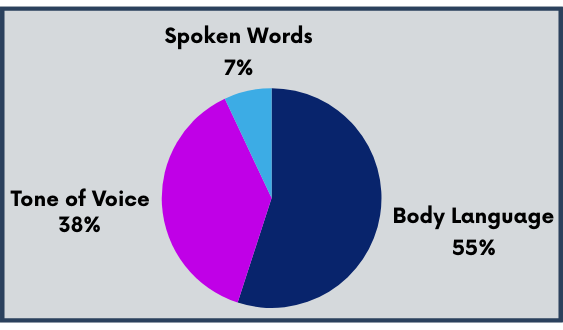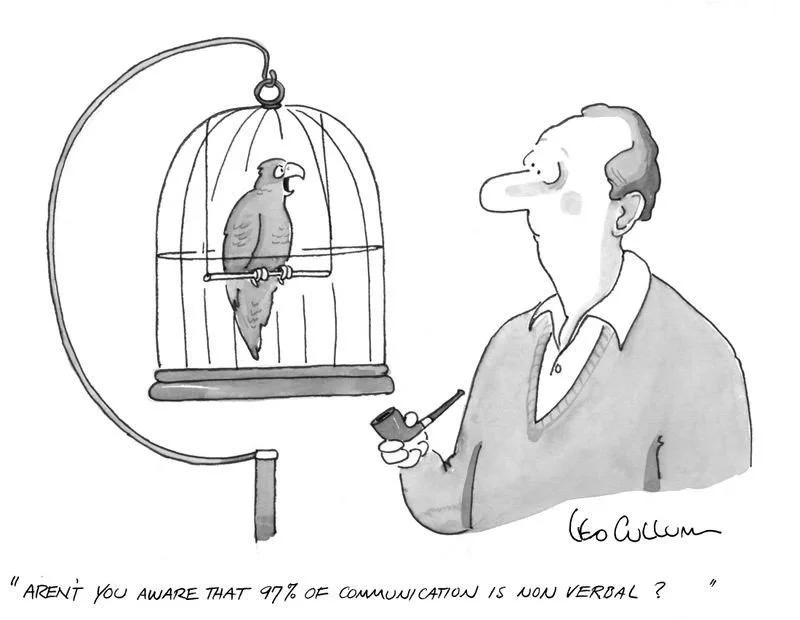Nonverbal Communication
Communication isn’t just about what we say. Much of what people remember, react to, or misunderstand comes from how we carry ourselves in the moment. Posture, tone, eye contact, and facial expressions can either support your message or create tension without a word being spoken.
In manufacturing environments like 3M Chem Ops, these signals matter. They affect how directions are received, how concerns are raised, and how safe people feel speaking up. When people are under pressure, they tend to rely more on what they see and hear in your tone, not just the content of your message. This shift isn’t always conscious—it’s a protective response. In tense moments, body language often feels more trustworthy than words, especially when there’s uncertainty or urgency.
Nonverbal communication isn’t always easy to notice in ourselves. You may believe you’re being clear or approachable, but your tone or posture may send a different signal. These mismatches can create confusion, especially in a place where clarity keeps teams aligned and focused on safe, reliable operations.
Self-Assessment: Nonverbal Communication
Please take a few moments to contemplate the following self-reflection questions. Where can you identify opportunities for personal growth in your leadership?
Am I aware of the nonverbal signals I project in various situations, such as facial expressions, body language, tone of voice, and gestures?
How might my nonverbal cues influence their perceptions and interactions with me?
Do my nonverbal cues align with the verbal messages I convey?
Have I sought feedback from trusted colleagues or mentors regarding my nonverbal communication?
Are there specific areas, such as maintaining eye contact, controlling facial expressions, or using gestures effectively, that I can focus on developing further?
How observant am I of nonverbal cues in the workplace environment?
Are there patterns or trends have I noticed in the nonverbal communication of my team members?
Do I respond the same way to my colleague’s nonverbal cues as I would expect them to respond to mine?
Remember, this self-assessment is just a starting point for understanding your knowledge of Nonverbal Communication as a leader. It's essential to reflect on your responses and actively work on areas where improvement is needed. Additionally, working with your ECFL Leadership Coach or seeking feedback from a trusted mentor can provide valuable insights into your strengths and weaknesses.
“The most important thing in communication is to hear what isn’t being said.”
You already know that communication goes beyond the words you speak or write. But have you considered the nonverbal message you're sending? Many leaders are unsure how they truly come across.
To strengthen your communication style, it’s essential to develop self-awareness about what supports—or undermines—your message nonverbally.
According to UCLA professor Albert Mehrabian's widely cited research, up to 55 percent of communication is conveyed through body language, 38 percent through tone, and only 7 percent through words. These figures apply specifically to situations where someone is expressing feelings or attitudes, but they highlight how much weight nonverbal cues carry, especially when it comes to your presence as a leader.
This session focuses on four core areas of nonverbal communication: eye contact, posture, gestures, and tone of voice.
The Eyes Have It
Our eyes are one of the most critical parts of nonverbal communication, demonstrating our willingness to connect with someone. Our eyes have power, for good or bad. Think back to your elementary years and the look your teacher would give someone in your class when they were talking during quiet time. Most of the time no words were needed, just the eyes with that intentional look saying to stop talking now.
In the workplace, eye contact can signal that we’re engaged and present. It can help others feel seen and respected, especially during moments that require focus or honesty. At the same time, a lack of eye contact can disrupt that connection. It might make someone question whether they’re being heard, or whether their message matters.
Not everyone maintains eye contact the same way. Some people find it difficult, especially when trying to focus on what they’re saying. That doesn’t mean they’re being rude or disengaged. When someone avoids eye contact or seems distracted, pause before assuming the worst. They may be nervous, deep in thought, or communicating in a way shaped by cultural norms or neurodiversity. Good leadership means recognizing and respecting those differences. Assume positive intent. Respond with empathy, not judgment. That’s what keeps communication open and trust intact.
If you’re a leader who struggles with eye contact, there are ways to stay connected without discomfort. You might try looking at the person’s forehead, focusing gently between the eyes, or alternating your gaze from one eye to the other. Another approach is to occasionally glance away and then return to the person’s face. These small adjustments help you maintain presence and attentiveness while honoring your own communication style.
“The most important things are the hardest to say because words diminish them.”
Genuine Gestures
Gestures are another important part of how we communicate nonverbally. They include movements of your hands, arms, or head that emphasize or reinforce your message. The way you use your body while speaking affects how people interpret what you’re saying.
When gestures are natural and intentional, they add clarity and keep people engaged. For example, pointing to a specific item, using open hands to invite discussion, or nodding to show understanding helps make your message more personal and accessible. These choices help others feel included, not just spoken to.
At the same time, it’s important to be aware of your context. In some settings or cultures, certain gestures may feel too animated or may be misread. Always be mindful of respecting personal space and cultural norms regarding physical contact. The goal is to be present and intentional in how you use movement to support your message.
Tone, Mood, and Meaning
Tone and mood affect how your message lands. A calm voice can put people at ease. A sharp or rushed tone can make them pull back. Even silence changes the feel of a conversation. These things aren’t just background; they often carry more weight than the words themselves.
Tone includes your pitch, volume, and pace. So do smaller cues like sighs, throat-clearing, or a long pause. You may not notice them, but others do. People often react to those signals first, especially in high-stress moments.
Silence also matters. It might mean someone is thinking, or it might mean they’re stuck. Without context, silence can create uncertainty. The goal isn’t to avoid silence but to be aware of how you’re using it. As you pay attention to tone and mood, you’ll begin to notice how your presence affects the energy in the room, and how you can shift it.
As you continue to develop your nonverbal communication skills, observe the great leaders of our time. How do they project themselves? What does their body language, including their tone of voice and use of silence, communicate? These observations can provide valuable insights into effective nonverbal communication strategies.
Although the words you choose are important, they only make up a small part of the overall message you convey when communicating. The more intentional you are with how you listen, move, and respond, the more clearly your leadership comes through. The habits below can help you build trust and consistency in the moments that matter most.
Here’s a quick checklist to help you be mindful of your nonverbal communication:
Be aware of your body language and facial expressions
Practice active listening cues like nodding and maintaining eye contact
Convey empathy through your tone and expressions
Keep your verbal and nonverbal messages consistent
Adjust your cues for different situations and cultural norms
Be mindful of and try to keep a calm, approachable expression
Respect personal space while staying open and present
Use gestures naturally and intentionally
Regulate your emotions so signals don’t get misread
Pay attention to others’ body language and tone
Even if it feels awkward at first, that’s okay—keep practicing
Many leaders find this work uncomfortable. It takes effort to examine how you really come across, but building that awareness is a necessary step toward stronger communication. Here are three simple strategies to help:
Mirror Practice: Spend a few minutes in front of a mirror each day. Practice different facial expressions and postures. This can help you become more aware of the nonverbal messages you're sending.
Record Yourself: Filming yourself during a mock meeting or presentation can provide insights into your body language habits.
Be Present: Put away any distractions to give the speaker your full attention. Remember that nonverbal communication is a fast-paced, back-and-forth exchange that demands your complete attention in the present moment. If you're mentally rehearsing your next response, glancing at your phone, or letting your mind wander, you'll likely overlook important nonverbal signals and fail to grasp the nuances of what's being conveyed.
Nonverbal communication is often subtle, but its impact is anything but small. At 3M Chem Ops, where safety and clarity are essential, leaders set the tone not just with words, but with how they show up for their team. From posture to tone, from gestures to eye contact, your presence sends a message. The more aware you become of that message, the more intentional and trustworthy your leadership can be.
Reflection Questions:
Think of a time when nonverbal cues led to a misunderstanding. What was missed, and what might have helped?
Do any of your team members struggle with nonverbal communication? How do you support them?
How do you adjust your approach for employees who may avoid eye contact? What helps you ensure they still feel respected and heard?
Strengthen your understanding of Nonverbal Communication by sticking with the following resources. Use this opportunity to note new insights and adhere to practices that will enhance your leadership journey.
The Art of Eye Contact: 4 Best Approaches for Any Interaction
Negative Nonverbal Communication (3:12)
Positive Nonverbal Communication (2:52)
Take Control of Your Non Verbal Communication
Dr Nick Morgan With HBR (6:33)










